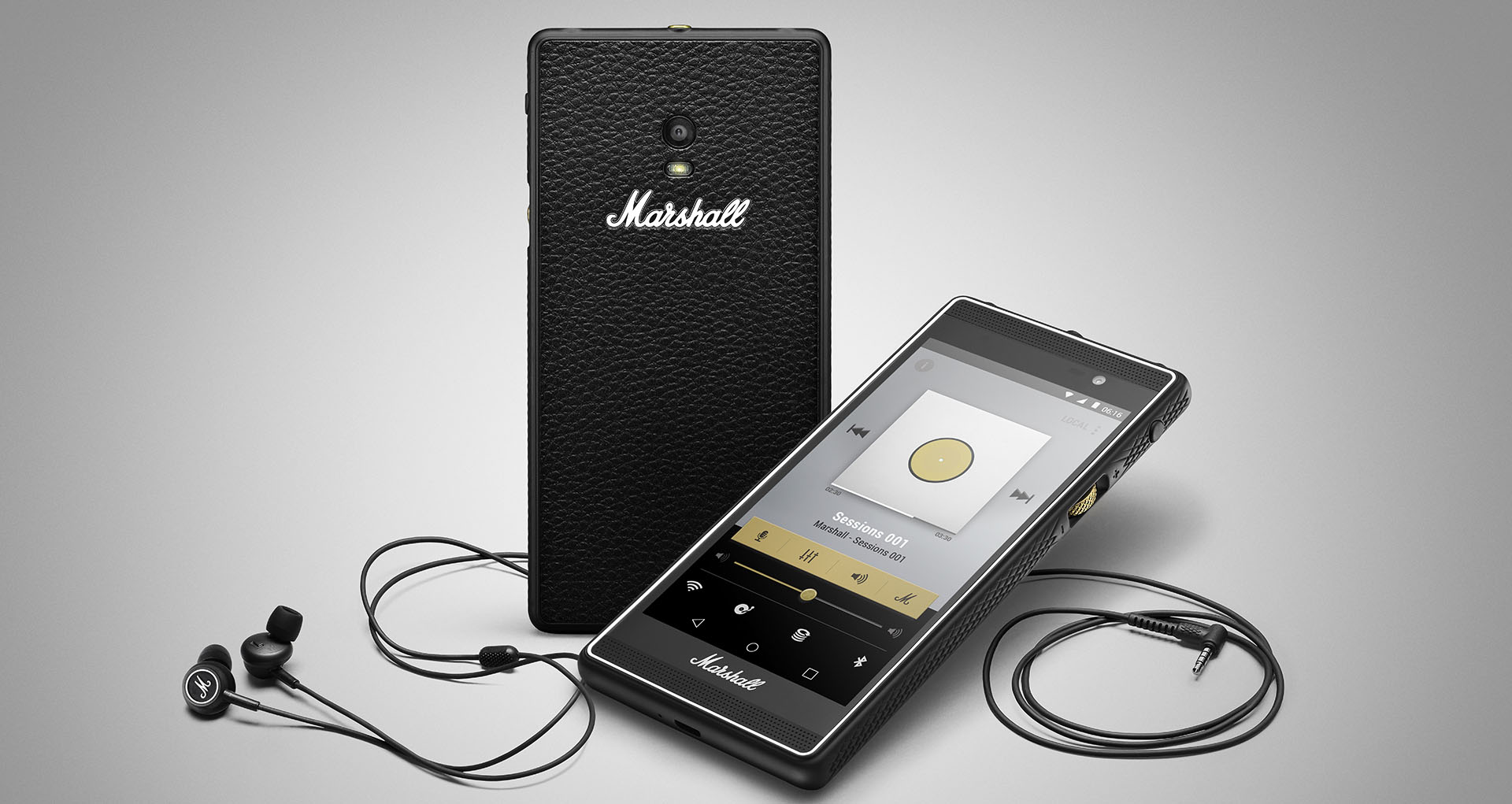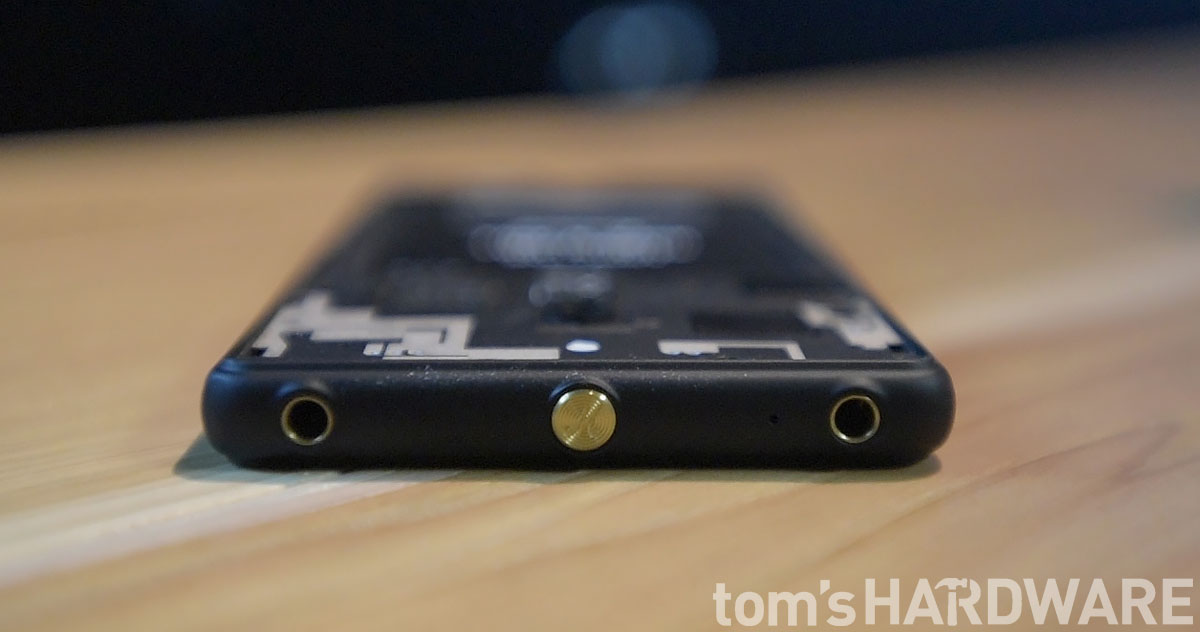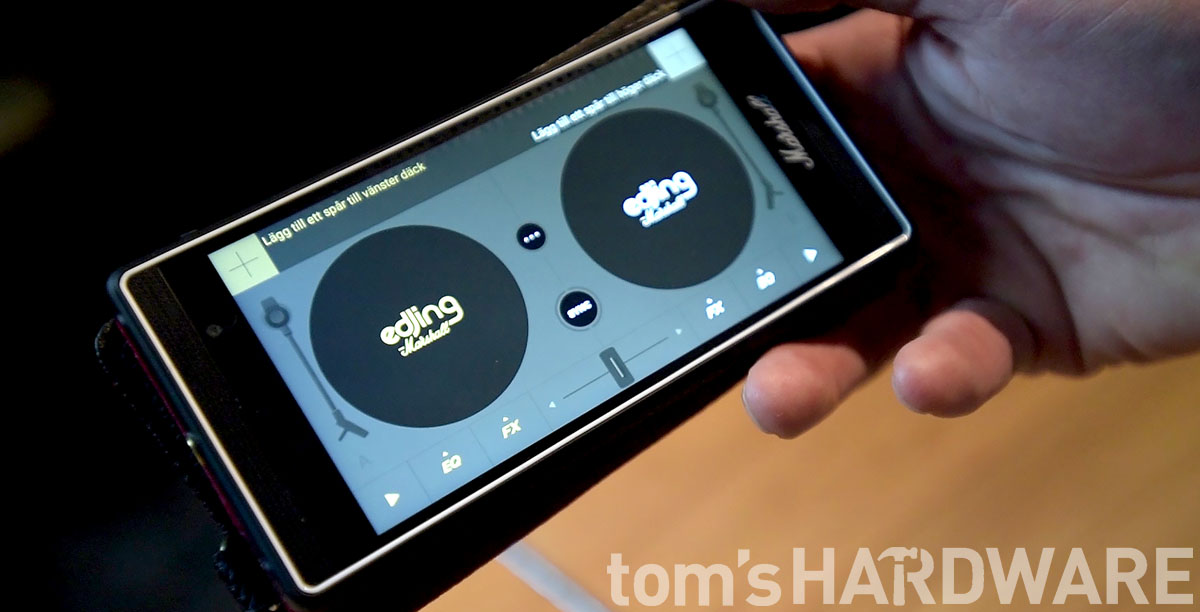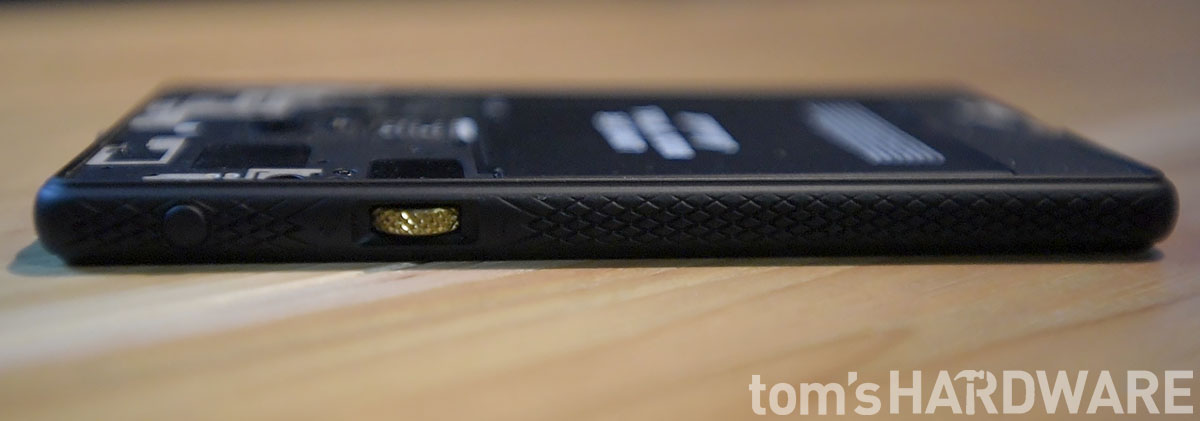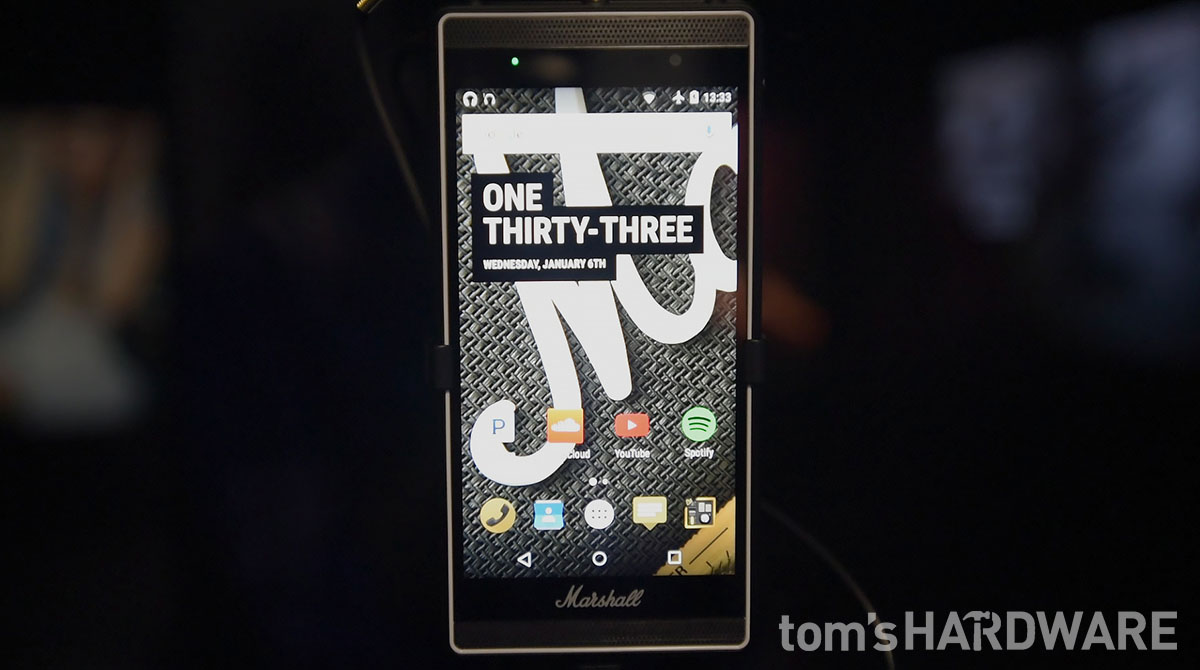Marshall's 'London' Smartphone Is Built For Music Creators
New types of electronics start as something unique and innovative, and then quickly reach a point where every company is making one. With Bluetooth speakers, this took around 18 months. Now we’re seeing the signs that smartphones have finally reached the point where nearly any large company can produce one. In a market like this, how do you stand out?
The Marshall London is both an example of the proliferation of phones, and a lesson in crafting a unique identity. Instead of another generic midrange phone, the Marshall London is selling itself as audio-focused device for music lovers, DJs, and musicians.
The London isn’t actually produced by Marshall Amplification, maker of guitar amps, speakers and pedals, but by Marshall Headphones. Marshall Headphones is the result of a licensing deal and partnership between Marshall and a Swedish electronics manufacturer called Zound Industries (which is also responsible for the UrbanEars line of headphones).
The first wave of Bluetooth speakers and headphones from Marshall/Zound were popular if not critically beloved -- kind of like Beats for the guitar rock set -- but their recent devices have earned some accolades for clear sound and a reasonable price.
The London is a new foray for the company, but it shares the same DNA as all the other products. It features extensive Marshall styling, from the use of black rubber and bronze to the ubiquitous logo, and is as focused on audio as a phone can be.
We got about an hour with the London at CES, and it certainly delivers as a powerful device for music fans, with a couple important caveats.
Double Your Pleasure
The London’s most noticeable feature is the dual headphone jacks on top, flanking a small bronze button. Having two audio jacks raises a host of possibilities that would be challenging or impossible with a standard smartphone. The banal bonus is that two people can listen to the same song, and each jack has independent volume control.
Get Tom's Hardware's best news and in-depth reviews, straight to your inbox.
Far more interesting are the implications for music production. For example, with two connectors you could attach headphones to one side and microphone to the other, letting you monitor while you record, which is crucial for accurate sound capture (the independant volume control is critical here as well). Furthermore, for house-party DJs wanting to up their game, the two ports let you playback tracks on one channel and preview and cue up tracks on the other. Marshall is clearly aware of this possibility and bundled the London with recording and DJing software.
The whole affair is powered by a Cirrus Logic (formerly Wolfson) WM8281 Audio Hub, a 24bit audio chip. Wolfson was a well-respected manufacturer of audio chips that were found everywhere from the Zune to most of the iPod lineup. They were acquired by a competitor, Cirrus Logic, which has continued to manufacture the WM8281. A Marshall rep said they actually had to dial down the output signal from the WM8281 so as to not overload the London’s dual front-facing speakers.
The WM8281 has been used in a few other devices, including the Lenovo K4 Note sold in Asia, but aside from that, details or reviews of the chip are scarce. Before being acquired, Wolfson’s chips were in a number of well-reviewed digital-analog converters, though Cirrus has chosen to reserve the WM8281’s datasheet, and exact details are scarce.
One advantage that a Marshall rep attributed to the new chip is that the London supports a wide range of file formats, including several high fidelity forms of audio. Most interestingly, the London can both natively playback and actually record FLAC, a popular open source lossless audio format. Additionally, the London can record in WAV and AAC+ (bizarrely, it can also record in AMR, the audio codec used for voice calls in GSM phones, and 3GPP, a mostly obsolete mobile audio/video container format based on MPEG-4)
| Specs | Marshall London |
|---|---|
| CPU | Qualcomm Snapdragon 410, 1.2 GHz Quad Core |
| Display | 4.7” LCD IPS HD 720P, Multi-touch, Gorilla glass 3, |
| Speakers | 2 x front speakers (13 mm x 18 mm) with enhanced volume & bass |
| OS | Android Lollipop 5.0.2 with customized music applications |
| Memory | 2 GB |
| Storage | 16 GB / Expandable microSD card |
| Connectivity | -Wi-Fi a/b/g/n 2.4 GHz / 5 Ghz-Bluetooth 4.1 with BLE & aptX |
| Cameras | -8 MP AF main camera w/flash-2 MP front camera |
| Battery | Removable 2500 mAh Li-Ion |
| Network | GSM / 3G / 4G LTE |
| Sound | Cirrus Logic WM881, 24 bit audio codec, hardware ADC/DAC, 2 headphone jacks |
| Weight | 145 g |
| Price | $500 |
There are two other unique features built into the London. First off is the volume control, which is actually a knurled wheel. Clicking the wheel immediately launches the camera, which we weren’t able to try out. The other control is the so-called “M” button between the headphone jacks. Clicking the M button will immediately launch Marshall Home, a specialized music hub app.
Marshall Home lets you control audio from popular sources, including Spotify, Google Music, Tidal, and Soundcloud, among others. The app can also launch the EQ, which is linked to the sound chip. This means all audio output is adjusted by the EQ, regardless of which app it’s played from. You can also find shortcuts to a recording app, Loopstack (a bundled 4-channel recorder/mixer), or a hub for music news.
Doesn't Quite Go To 11
Audio is not the only thing we use phones for, though, and on the hardware side, the London is less “rock and roll” and more “easy listening.” The London runs a fairly low-powered chip, the Snapdragon 410 clocked to 1.2 GHz, and although we weren’t able to test out the camera, it’s an 8MP affair, without phase-detect focus or other advanced features. The phone comes with just 16 GB storage, though it does support microSD cards. The 2,500 mAh battery should be plenty, especially considering it’s replaceable.
I expected to dislike the 4.7-inch 720p LCD screen, which quite low resolution for a modern Android phone, but surprisingly, it seemed fine. Blacks and colors certainly didn’t pop as much as they do on a high-resolution AMOLED panel, but 720p is still enough resolution to deliver a pixel density of 312PPI, which is just under the iPhone 6/s’s 326PPI.
My biggest complaint was with some of the bundled software. There seemed to be a number of redundant apps, and it wasn’t always clear what certain settings were changing. For example, the EQ can be accessed either through the Marshall Home app or through the bundled music player. Changing settings in either app seemed to make a universal change, but it wasn’t always clear. The two EQs are actually styled differently, visually, with options and buttons in different places.
Similarly, there is an audio recording app that is part of Marshall Home, and it gives you the option to record in a number of formats, including FLAC. However, there is another audio recording app in the app drawer that looks entirely different and doesn’t appear to give any format options. Are changes made in Marshall Home applied to the other app?
Personally, it was a hatred of redundant, useless, bundled apps that initially drove me to rooting phones, and later to Nexus devices. Overall, Marshall’s bundled apps and alterations to Android seem minor, and mostly desireable, but I hope they sort out these ambiguities. The London is currently running a modified version of Android 5.0.2, though a rep did say that work was underway on an Android 6 update.
Despite the midrange specs, Marshall is pricing this phone in flagship territory. For $500, the Marshall won’t win any benchmarks against other phones in its price class (the $180 2015 Moto G features the same chip, clocked 0.2GHz faster), but Marshall is clearly betting on the unique styling and audio focus to attract fans. The London is not currently available in the U.S., though it should be on sale stateside by the middle of next year.
-
dstarr3 Honestly, if it weren't for the screen, I'd probably want this. I'm sure the camera is pretty lackluster, but I've never been impressed by any cell phone camera yet, so that's a wash for me. But... 720p, man. For that inflated price tag, surely they could have tacked on a 1080p screen.Reply -
Mac266 ReplyHonestly, if it weren't for the screen, I'd probably want this. I'm sure the camera is pretty lackluster, but I've never been impressed by any cell phone camera yet, so that's a wash for me. But... 720p, man. For that inflated price tag, surely they could have tacked on a 1080p screen.
Y'know, that's what I don't get from most High end Android phones these days. Why exactly would I want a 1440p screen when the device is only 5" or so big? I mean, let's be honest, 1080p is the most common Monitor resolution, and I'm pretty sure that's larger than 5".
-
Calvin Huang Reply
People often use their smartphones at a much closer distance than other digital devices. I have an old S4A, and it's 1080p, which seems to make it as crisp as my 1800p laptop at the distances I view each at. Granted, the Marshall London has a slightly smaller display (4.7" vs 5"), but if you're going to be watching videos on it, reading, playing games, you'll probably be staring at it closely enough that you can notice the difference.Honestly, if it weren't for the screen, I'd probably want this. I'm sure the camera is pretty lackluster, but I've never been impressed by any cell phone camera yet, so that's a wash for me. But... 720p, man. For that inflated price tag, surely they could have tacked on a 1080p screen.
Y'know, that's what I don't get from most High end Android phones these days. Why exactly would I want a 1440p screen when the device is only 5" or so big? I mean, let's be honest, 1080p is the most common Monitor resolution, and I'm pretty sure that's larger than 5".
But, at the end of the day, it still comes down to personal preference. Some people won't notice the difference between 1080p and 1800p on a 15" laptop screen. I can (especially when I'm doing graphic design). Likewise, I definitely noticed the jump from 720p to 1080p when I went from the S3 to S4A. But I probably can't tell the difference between a 60Hz refresh rate than a 120Hz one whereas many gamers seem to be able to.
Lastly, what's acceptable depends on what you've previously experienced. If you've never had a 400+ ppi phone, you're not going to feel like you're missing anything. I mean, back in 1998, none of us thought there'd ever be a market for a 4k display. -
Nossy Pretty weak audio chip for a specialized audio device. But then again, if you buy Beats and Bose...Reply -
Stefan_W Reply17348402 said:Pretty weak audio chip for a specialized audio device. But then again, if you buy Beats and Bose...
I don't quite understand how you can call the Wolfson WM8281 a weak audio chip, especially if it is used in top of the line discreet audio players. -
Stefan_W Reply17347112 said:
People often use their smartphones at a much closer distance than other digital devices. I have an old S4A, and it's 1080p, which seems to make it as crisp as my 1800p laptop at the distances I view each at. Granted, the Marshall London has a slightly smaller display (4.7" vs 5"), but if you're going to be watching videos on it, reading, playing games, you'll probably be staring at it closely enough that you can notice the difference.Honestly, if it weren't for the screen, I'd probably want this. I'm sure the camera is pretty lackluster, but I've never been impressed by any cell phone camera yet, so that's a wash for me. But... 720p, man. For that inflated price tag, surely they could have tacked on a 1080p screen.
Y'know, that's what I don't get from most High end Android phones these days. Why exactly would I want a 1440p screen when the device is only 5" or so big? I mean, let's be honest, 1080p is the most common Monitor resolution, and I'm pretty sure that's larger than 5".
But, at the end of the day, it still comes down to personal preference. Some people won't notice the difference between 1080p and 1800p on a 15" laptop screen. I can (especially when I'm doing graphic design). Likewise, I definitely noticed the jump from 720p to 1080p when I went from the S3 to S4A. But I probably can't tell the difference between a 60Hz refresh rate than a 120Hz one whereas many gamers seem to be able to.
Lastly, what's acceptable depends on what you've previously experienced. If you've never had a 400+ ppi phone, you're not going to feel like you're missing anything. I mean, back in 1998, none of us thought there'd ever be a market for a 4k display.
Reasons that 720p was chosen:
- Development team compared 1080p vs 720p 4.7 inch displays, when users were shown the 2 screens, the majority actually preferred the 720p resolution, very few could guess that the other screen was 1080p. Our conclusion was that 95% users did not notice positive results with 1080p on smaller than 5-inch screens.
- Battery life was a key consideration, especially for a music phone / smartphone. A 720p screen on a Snapdragon 410 provides best battery life (& sustained performance) compared to the 610 and 810, both of which had overheating/throttling issues.
-
Bloob I don't really mind the 720p, prefer it actually on a device that size, but would have liked a stronger SoC (SD808 or SD615/618), even then it would be quite pricey. Then again, I do most of my music-listening while stationary, so maybe more mobile (pun intended) people would be willing to pay that. Nor would I benefit from dual output in any way.Reply -
traverser Oh, what a tastefully designed phone. I can see this appealing to not just audiophile/musicians but people who are looking for something different to the other phones everyone and their grandparents use. The size is ideal for me, and I don't mind the 720 resolution. Heck I still don't see the need to replace my 42" 720 plasma.Reply -
turkey3_scratch Reply17345053 said:Honestly, if it weren't for the screen, I'd probably want this. I'm sure the camera is pretty lackluster, but I've never been impressed by any cell phone camera yet, so that's a wash for me. But... 720p, man. For that inflated price tag, surely they could have tacked on a 1080p screen.
Y'know, that's what I don't get from most High end Android phones these days. Why exactly would I want a 1440p screen when the device is only 5" or so big? I mean, let's be honest, 1080p is the most common Monitor resolution, and I'm pretty sure that's larger than 5".
Exactly. My 2D text and anti-aliased bubbles aren't going to look any different to me on a 5" phone from 1080p to 1440p.
